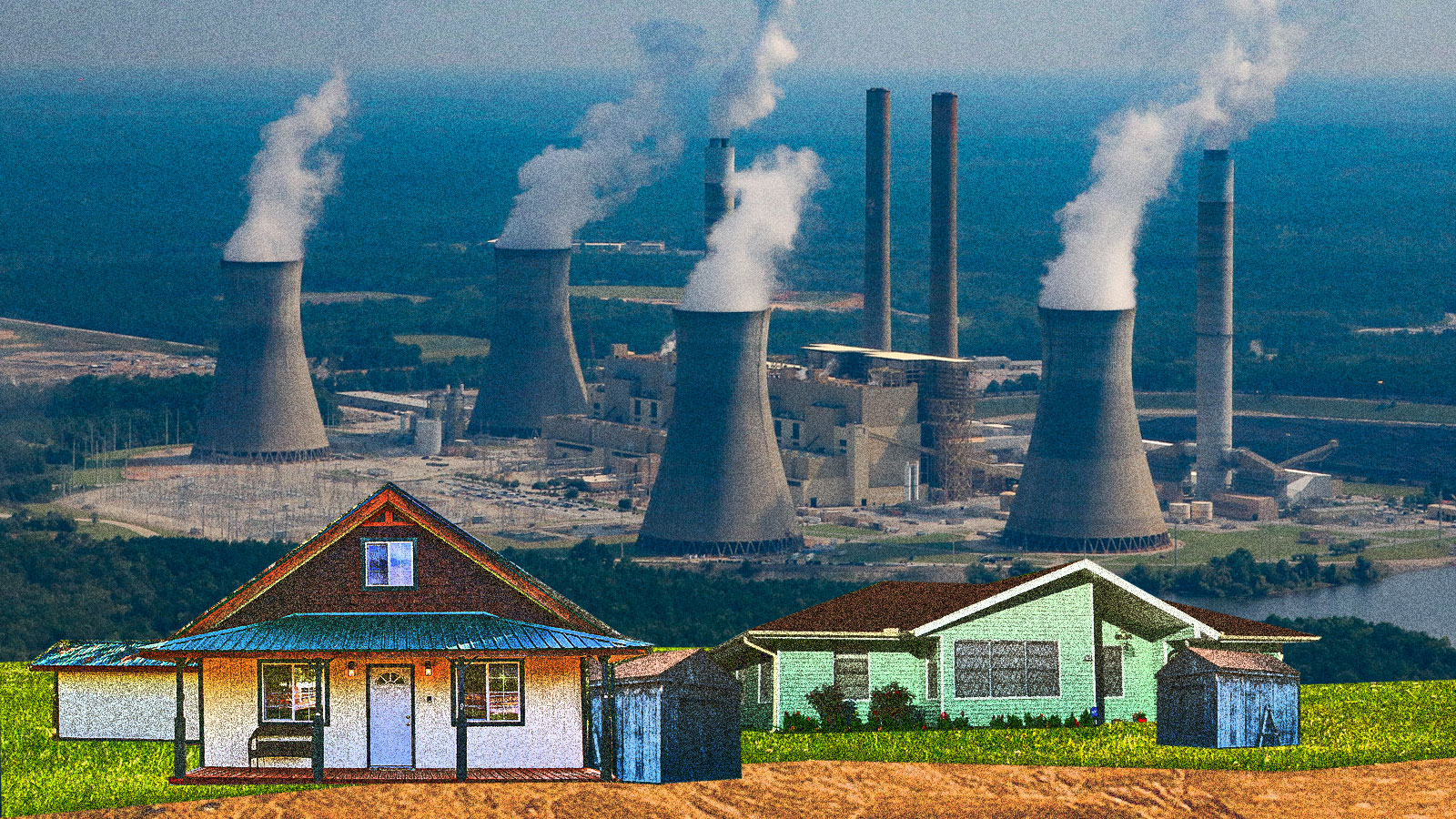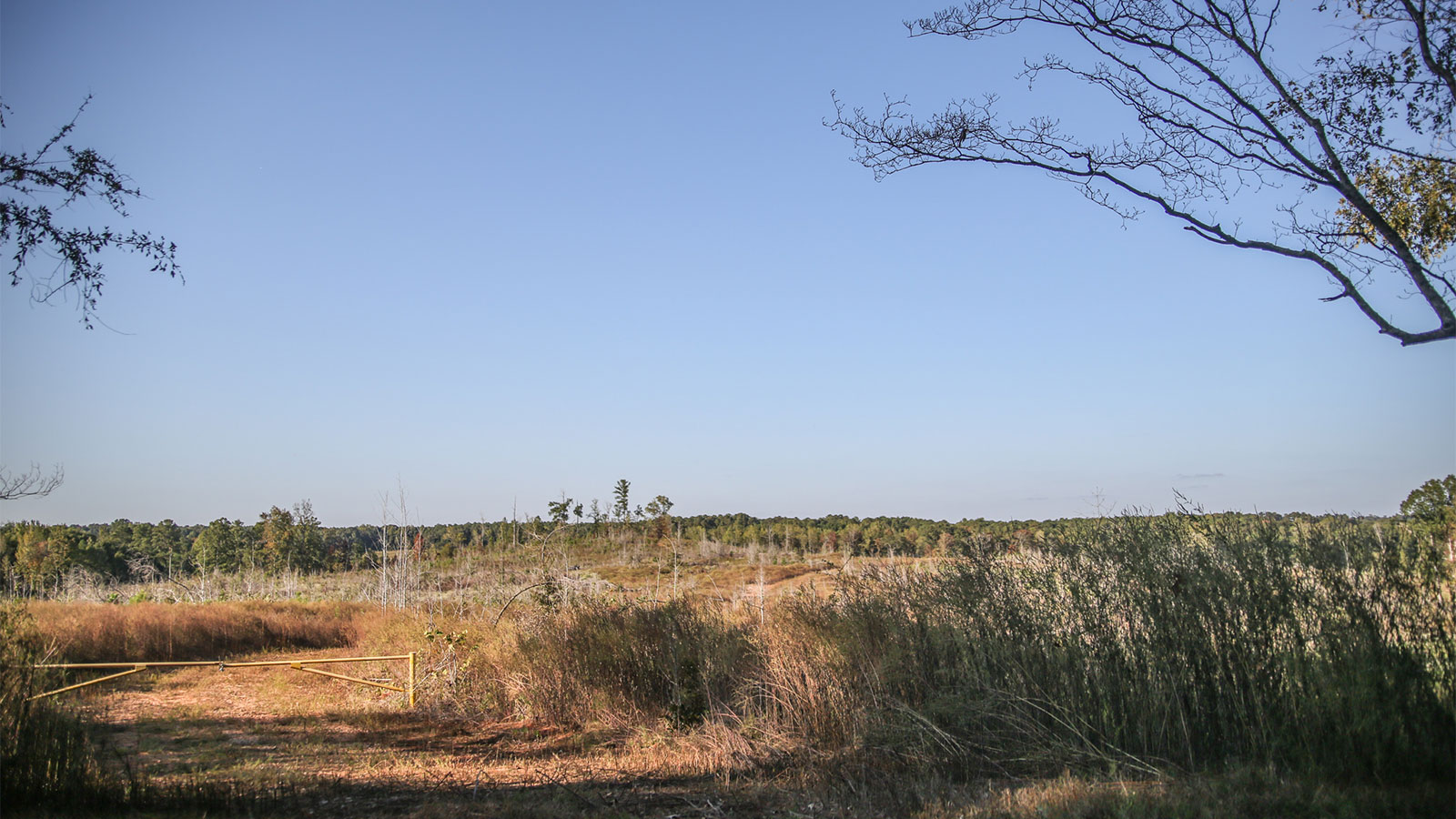Without Tony Bowdoin’s grandfather, Georgia Power might never have come to the quiet town of Juliette. The central Georgia hamlet, just off the Ocmulgee River and a little over an hour’s drive south of Atlanta, is mostly known as home to some of the state’s best shoal bass fishing. Juliette’s only other claim to fame is its turn as the setting for the 1991 Oscar-nominated film Fried Green Tomatoes.
Bowdoin’s grandfather, Marvin, not only helped sell the utility on Juliette, he sold Juliette on the utility’s promises of jobs, benefits, and pensions. By the late 1960s, Georgia Power had started planning to build the Robert W. Scherer Power Plant. Over a decade later, in 1982, its first unit opened in Juliette. The plant breathed life into the old mill town, employing some 400 locals and pumping nearly $7 million annually into Monroe County’s coffers.
But there were downsides: Georgia Power had seized hundreds of acres — including homes — via eminent domain during its early years in town. Tony Bowdoin had also heard whispers about pollution over the years. The 57-year-old had seen the “Save Juliette” graffiti scrawled across a nearby salon and stop sign, but his life’s work — running the family grocery — had left little time to investigate further. So when a neighbor recently called with the news that her tap water contained enough contaminants that she had switched to drinking bottled water, he called an environmental nonprofit to get his drinking water tested.
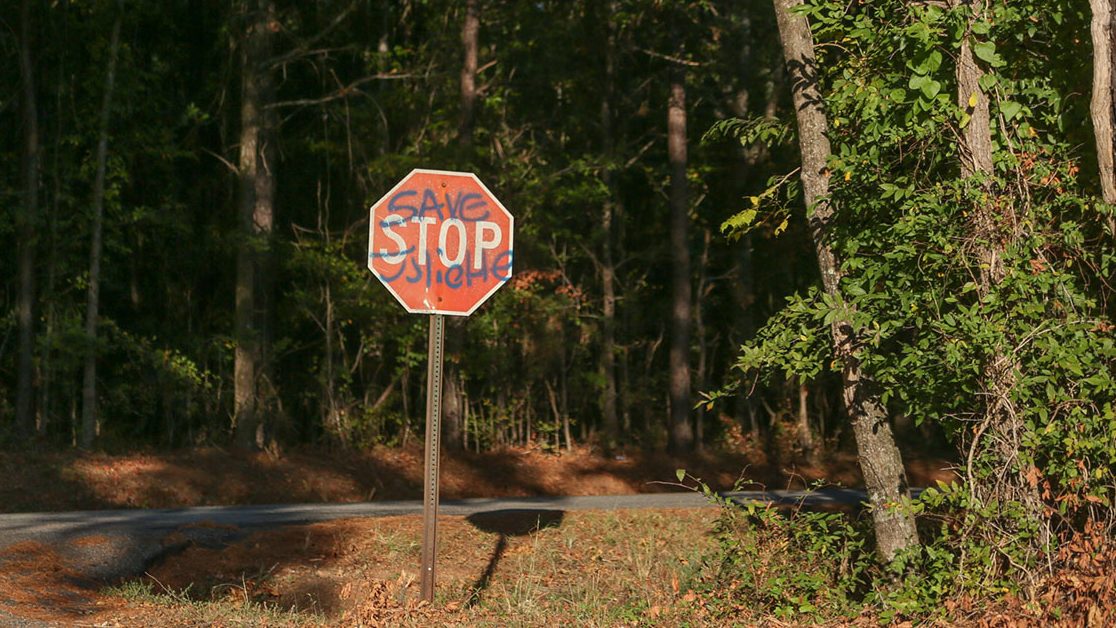
On a sweltering late-August day, a pair of red vehicles pulled down Bowdoin’s driveway, carrying Jen Hilburn and Fletcher Sams of the Altamaha Riverkeeper. The organization is primarily responsible for protecting a river that empties into the Atlantic Ocean some 200 miles southeast of Juliette, but the Ocmulgee River is one of the Altamaha’s northern tributaries, so any risk to it and its surroundings could wind up in the Riverkeeper’s purview. Because Juliette is far enough from the two closest cities with municipal water systems, Macon and Forsyth, most of its residents rely on wells that draw up groundwater. So Hilburn and Sams had begun a covert water-testing campaign in Juliette, where they suspected there was widespread groundwater contamination linked to Plant Scherer’s operations.
Bowdoin, Hilburn, and Sams headed to the side of the vinyl-sided house, where Bowdoin’s well is located. A 49-year-old who bears a passing resemblance to the Parks and Recreation character Leslie Knope, Hilburn squeezed her hands into a pair of blue latex gloves. Then she broke the seal on a sterile plastic bottle, unscrewed the cap, and delicately filled the bottle one cap full at a time. She repeated this process two more times, as the samples were cataloged by Sams, a stocky 38-year-old ex-political operative dressed in a button-down and khakis. The three samples would be sent to Pace Analytical, a North Carolina environmental lab, to test for boron and strontium — the DNA fingerprints of coal ash, a byproduct of burning coal — as well as cobalt, arsenic, and hexavalent chromium, the toxic chemical that Erin Brockovich found in Southern California drinking wells, which turns up in coal ash disposal sites from Massachusetts to Nevada.

“Nobody’s ever cared about Juliette,” Bowdoin said. He liked Hilburn and Sams — trusted them, even — because they took residents’ concerns seriously. So much so that, after Hilburn and Sams finished testing his well, Bowdoin started his Ford pickup and volunteered to lead them to his family and friends’ homes for more sampling. They eventually reached a stretch of Luther Smith Road, a largely unpaved street that runs along Scherer’s northern edge. On one side, a thick black slurry of coal ash glistened through the cracks among Georgia pines. On the other, Georgia Power’s “no trespassing” signs lined the fences of properties it had purchased from families, mostly within the past five years.
The acquired land could tell a story about the environmental and public health costs of inviting a coal plant to town. The Riverkeeper hopes its testing will provide answers to questions that have roiled growing numbers of residents grappling with stories of sickness and premature death. Its findings could not only tell of contamination that’s already taken hold, but help prevent the burial of tons of black slurry that’s likely to bring more. The environmental advocates are racing the clock — as the very business of coal ash disposal in states like Georgia is in flux, potentially endangering towns like Juliette.
The Riverkeeper’s results could give the people of Juliette the power to fight back.
Hilburn and Sams boarded a white single-engine plane on a clear day last summer and circled around 12,000 acres of land owned by Georgia Power. Flying north from Macon, it doesn’t take long to see Plant Scherer’s smokestacks on the horizon. The plant is so powerful that it can light up more than half of Georgia’s 3.7 million households. Every hour, workers pulverize roughly 1,300 tons of coal into a fine powder that’s placed into boilers and scorched to produce steam. From there, steam pushes turbine blades that spin a generator. Smoke rises from the dual 1,000-foot chimneys, which are part of a site that’s considered one of the highest emitters of greenhouse gases in the western hemisphere.
The view from above is dramatic, but the two Altamaha Riverkeeper employees are more interested in the thick black sludge darkening the ground below. Once coal becomes ash, Georgia Power mixes it with water and stores it in ponds collectively large enough to hold roughly 4,700 Olympic-sized swimming pools of contents. But whereas in a pool, the cement barrier keeps water from spilling out, no protective lining exists between the waste and the land underneath.

More than 1 million Americans reside within 3 miles of a coal plant, like this one. And most of the country’s coal ash ponds are unlined, according to the legal nonprofit Earthjustice. To date, the U.S. Environmental Protection Agency has not deemed coal ash hazardous, even though many of the chemicals in it are acknowledged toxins. Thus, unlined coal ash ponds deep enough that they close in on the water table can contaminate local groundwater supplies, said Chris Groves, a Western Kentucky University hydrogeology professor. A recent report by the Southern Environmental Law Center, or SELC, found that Scherer’s coal ash was at least 75 feet deep, fewer than 5 feet above the water table. It stated that coal ash in an unlined pond “will be capable of leaching toxic metals into Georgia’s groundwater.” In homes that have private wells, a pump is used to draw water up a pipe, which is then filtered for sediment. Some residents have purchased additional water filters to reduce the levels of heavy metals that may be in the water, while others boil their water as a precaution, though Hilburn notes that neither fully eliminates the threat.
During the Obama administration, a series of regulations designed to protect the environment sent shockwaves through the coal industry. Rules governing air pollution and the spewing of toxic chemicals like mercury from plant smokestacks prompted utilities like Georgia Power to retire plants in part due to the costs of complying with regulations. While the plant in Juliette will remain open, Georgia Power announced plans to shutter 29 ash ponds in early 2016, including Scherer’s, as a result of the administration’s 2015 coal ash rule, the nation’s largest set of regulations for the byproduct. The utility currently recycles about three-quarters of newly-produced coal ash at Scherer and other plants for use in products like cement, drywall, and cinder blocks, but for the existing waste, Georgia Power intends to “dewater” millions of cubic yards of ash and pack it into a smaller space. The Altamaha Riverkeeper believes Georgia Power’s disposal strategy is flawed — specifically because it doesn’t involve adding a lining as the pond transitions to what would essentially be a landfill. Chris Bowers, an SELC attorney, said allowing Scherer’s coal ash disposal site to remain unlined would exacerbate what he describes as a “slower moving, but equally concerning, kind of disaster” on par with headline-grabbing coal-ash spills at the Tennessee Valley Authority’s Kingston Fossil Plant, half an hour west of Knoxville, and Duke Energy’s Dan River site, near North Carolina’s border with Virginia. (Just after the New Year, North Carolina announced that in the wake of the 2014 Dan River accident, it had come to an agreement with Duke on “the largest coal ash cleanup in the nation’s history,” with the utility pledging to excavate close to 80 million tons and move it to lined landfills.)
Over the course of the past year, Hilburn and Sams have gathered water samples that they say show coal ash has leaked into both Lake Juliette as well as groundwater consumed by residents. They’ve tested 29 wells, and nearly every sample has contained potentially unsafe levels of hexavalent chromium, which is linked to ulcers, liver and kidney failure, and cancer. Sams says those initial findings suggest groundwater near Scherer could be more widely contaminated than the utility has previously reported.
Under the Obama-era coal ash rules, Georgia Power has had to monitor for potential leaks. The company’s own tests have detected elevated levels of cobalt — which can cause thyroid damage — according to a 2018 analysis of the utility’s data by Earthjustice and the Environmental Integrity Project, or EIP, a watchdog group made up of ex-EPA staffers. The two environmental organizations also found that 11 of Georgia’s 12 coal-fired plants, including Scherer, have contaminated nearby groundwater. That finding is all the more alarming, environmental experts and advocates say, considering that nearly two years ago the state requested permission to take over regulation of coal ash disposal from the federal government. The move would exempt Georgia plants from having to line their coal ash ponds and potentially limit the ability to sue over environmental concerns.
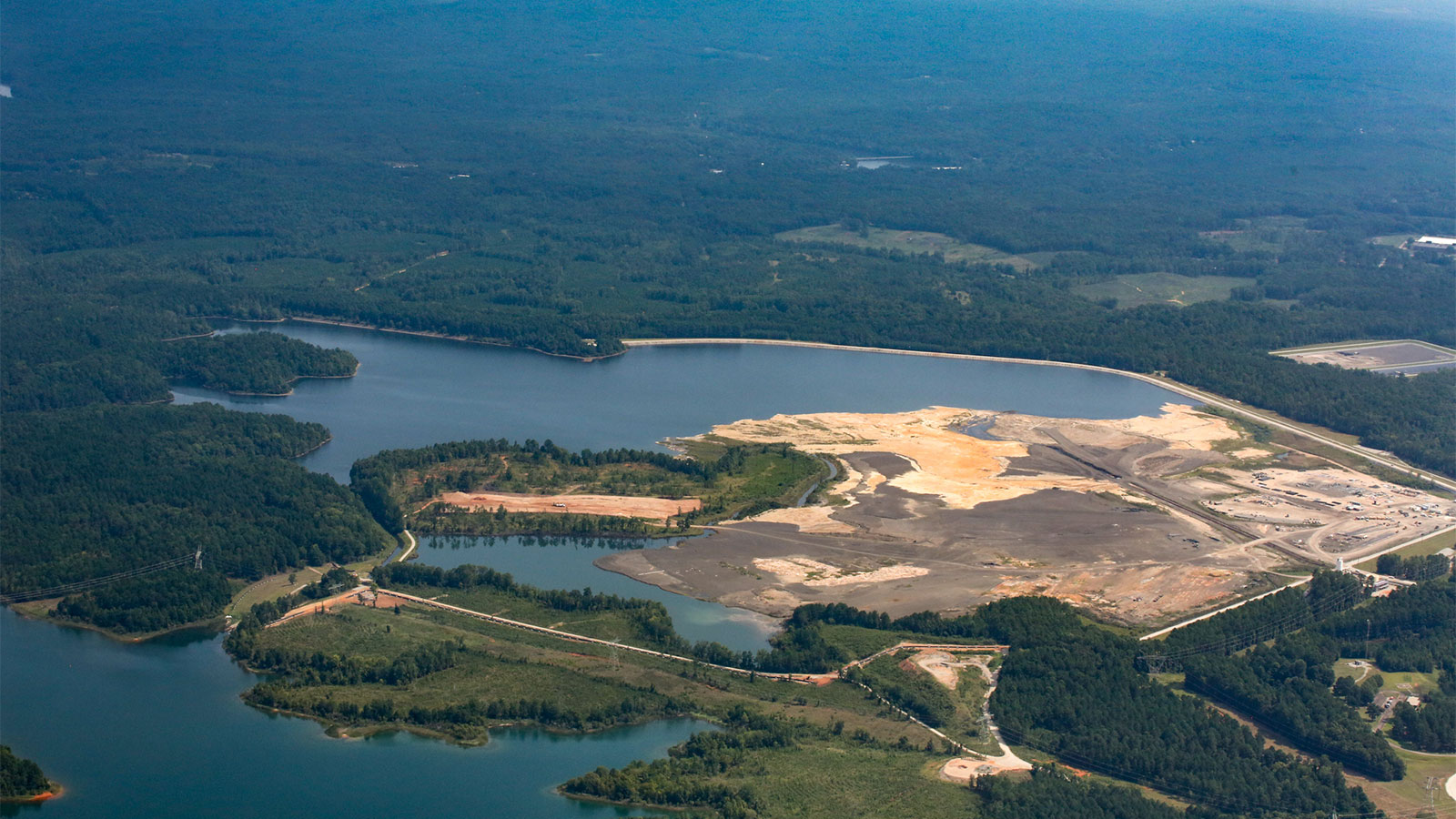
Sams hopes the Riverkeeper’s testing will pressure Georgia Power into creating what they believe is a safer coal ash-disposal plan. This past summer, Hilburn and Sams joined a small army of residents, advocates, and scientists who spoke at an Atlanta EPA hearing, and asked the three-person panel from the agency to deny the state’s coal ash regulation request. Hilburn warned that Georgia’s environmental regulators have too little funding and staffing to properly monitor how the ash was disposed of. The opponents said they worried the state would limit public input on future permits for waste sites. (A Georgia Environmental Protection Division spokesperson declined to comment.)
Advocates say Juliette shows how listening to locals is necessary: Georgia Power’s own monitoring of Scherer’s wells had detected “elevated concentrations” of cobalt and boron, according to Earthjustice and EIP’s analysis of the data. But Hilburn said the results were buried deep in complex reports that left many Juliette residents in the dark. Further, Hilburn and Sams believe that Juliette’s reliance on groundwater as its primary source of drinking water amplifies the threat from unlined coal ash ponds.
Holly Crawford, a spokesperson for Georgia Power, said that “the company has identified no risk to public health or drinking water.” Last month, the EPA’s top boss, Andrew Wheeler, a former coal lobbyist, approved Georgia’s permit. The Altamaha Riverkeeper has already plotted its next steps in Juliette. More home visits. More well testing. More evidence. “Georgians deserve better,” Sams said.
Neither Hilburn nor Sams ever imagined squaring off with Georgia’s largest utility, a subsidiary of the Southern Company, the United States’ second-largest energy provider. Hilburn, an Oregon native who grew up loving the outdoors, spent most of her career as an ornithologist studying macaws in Costa Rica, loggerhead shrikes on California’s San Clemente Island, and red knots in St. Catherines Island off the Georgia coast. Restless with the slow pace of research, she started to look for work that could more quickly produce tangible results. In 2014, the Altamaha Riverkeeper hired Hilburn to oversee its coastal initiatives. As the months passed, she learned the tiny 137-mile river had one of the East Coast’s largest drain basins, stretching from the Georgia coast, 60 miles south of Savannah, up to the Blue Ridge Mountains’ foothills. The following year, she took over the entire operation.

It was an attorney with the Waterkeeper Alliance, an association of over 300 environmental organizations, who turned her attention to coal ash. He took her to Lake Juliette, a Georgia Power reservoir that’s filled by pumping water from the nearby Ocmulgee River. Hilburn learned to collect water samples and spot surface leaks. She was soon asking veteran riverkeepers about the intricacies of ash, filing open records requests for state environmental data, and following the changing regulations in Washington, D.C. In 2016, Hilburn received an anonymous tip that heavy rains had forced Georgia Power to pump coal ash from the shuttered Plant Branch site in Milledgeville — an hour east of Scherer and also along the Altamaha drainage basin — into a nearby recreational lake overseen by the utility. Hilburn flew a drone overhead, captured images, and complained to state officials. Though a Georgia Power spokesperson said the company complied with its permits, Hilburn believes her documentation pressured the utility to excavate Branch’s coal ash from an unlined pond to prevent future leaks.
As she learned more, Hilburn kept visiting Juliette to speak with homeowners who kept asking her to test their water. She began collecting samples under homes, from kitchen sinks, and in backyard wells. This past spring, she gained some much-needed help in the form of Sams. A ninth-generation Georgian, Sams was raised in a deeply conservative family, and joined the U.S. Army after the 9/11 attacks. After returning from a deployment in Iraq, Sams grew disillusioned with the Republican Party and started working on Democratic campaigns across the South. In the summer of 2017, Sams joined the Cajun Navy, helping to track down residents and bring them to safety in Hurricane Harvey’s aftermath. The chance to work with Altamaha Riverkeeper allowed him to repurpose his political chops to protect his home state’s waterways. “When I first heard about coal ash, I’d never been pissed off about something that much — even about fighting wars over oil,” Sams said. It wouldn’t be long until he’d call on his connections in the state legislature to look into it.
Max Blau
Hilburn and Sams focused their testing on the homes nearest to Scherer — particularly those that remained on Luther Smith Road. About a decade ago, Georgia Power had begun purchasing land around Scherer’s northern and eastern edges. Since 2015, it has gone on a buying spree. According to an analysis conducted by the Altamaha Riverkeeper, Georgia Power paid $11.7 million to acquire over 1,500 acres appraised at just $2.1 million total. On Luther Smith Road, Georgia Power quickly razed family homes and sealed drinking wells — making them nearly impossible to test, even if one were to trespass on that property. Crawford from Georgia Power said the company purchased the property to increase the “buffer area” around the plant to “ensure safe operations and to minimize both short and long-term inconvenience for our neighbors.”
In February 2019, Mark Goolsby, who then lived on Luther Smith Road, told the Cobb County Courier he had “pictures of groundwater coming out of the ground like oil,” along with a well that had high concentrations of boron, cobalt, and hexavalent chromium. “Pictures don’t lie,” he said. “Now we’re having to sell.” By then Hilburn had already tested his well and others along the road. Confidentiality agreements have largely forced the families who sold their properties above market value — including the Goolsby’s — to stay silent, according to multiple sources with direct knowledge of those deals who asked to remain anonymous due to concerns over retribution. Crawford noted that confidentiality agreements are common in Georgia Power’s land deals, and did not offer an explanation for why the utility overpaid for the land. But Hilburn suspects that the utility paid a premium for that land in part because it had gotten wind of the Riverkeeper’s well testing.
Hilburn and Sams recently tested the well of Sidney and Linda Newsome, who they were introduced to by Bowdoin and whose house sits a short drive from Luther Smith Road. Homeowners since the ’80s, they had declined Georgia Power’s offer to buy a portion of their land. When they asked about the Riverkeeper’s preliminary findings, Hilburn replied that the problem was “bigger than we thought.”
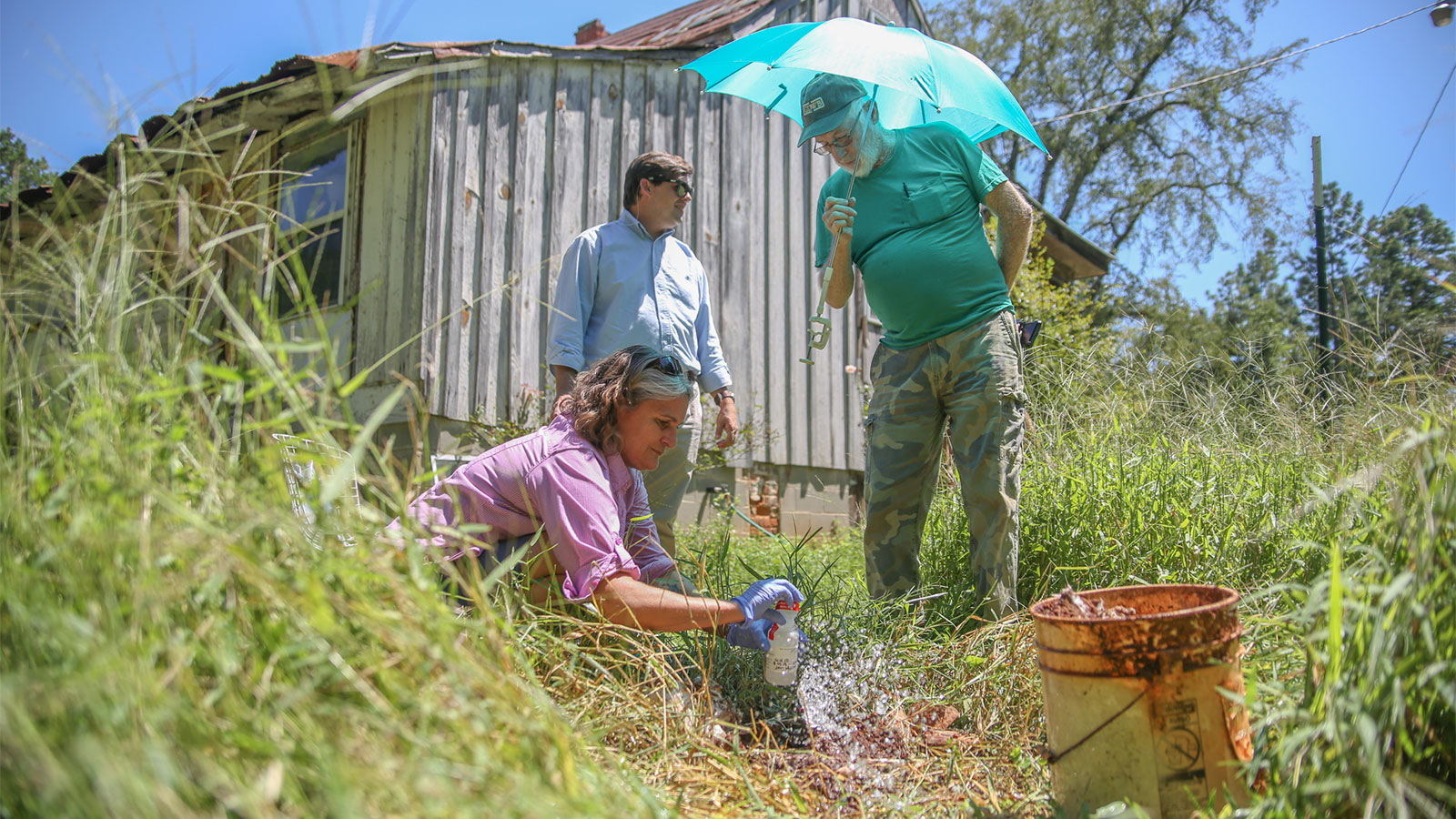
“It’s only going to get worse,” said Bowdoin, standing nearby, shaking his head.
“We haven’t found many clean wells,” Sams said.
“Any,” Hilburn responded. “I’d love for yours to be the first.”
Just before Labor Day, a dozen Democratic state lawmakers convened in Atlanta to discuss how to protect Georgia’s water. The group had anticipated that Wheeler’s EPA would grant the state’s coal ash permitting request. They sat around a long wooden table, across the street from the Georgia State Capitol, listening to Hilburn and Sams break down the environmental and public health costs of coal ash. Sams sketched out the potential legislative action the lawmakers could take, which would pit them against both a GOP-controlled legislature and a utility with one of the largest lobbying forces in the state. A review by Georgia Health News and Grist found the Southern Company and Georgia Power, along with affiliated political action committees and individual employees, donated over $1.7 million to state lawmakers — mostly Republicans — between 2014 and 2019.
Sams presented two options: First, there was the “Virginia” bill modeled after legislation that required Richmond-based Dominion Energy to excavate coal ash from unlined ponds, and either recycle it into cement and other products, or move into landfills. Most of the assembled agreed that if they chose this option, Georgia Power would potentially be successful in fighting the “Virginia” bill.
The second option was the so-called “banana peel” bill. As Sams explained, Georgia law prohibited solid-waste landfills from operating within 2 miles of a “recharge zone,” the surface area in which water can enter an aquifer. Coal ash ponds were long exempt from this rule. There was a simple solution: Change the definition of “solid waste” to include coal ash. Democrats were giddy. It was simple, easy to follow, and more likely to get support from Republicans with constituents near coal plants, or those in south Georgia who represented farmers that relied on clean water.
Leaning back in his seersucker suit, House Minority Leader Bob Trammell declared: “You can talk about coal ash all day long, but you mention landfill …”
Ever the message man, Sams put it another way: “When you’re basically breaking it down, household garbage — banana peels and coffee grounds — are more protected than this stuff.”
“That’s such a good soundbite,” one lawmaker said.
“When you have daddies and mommies with kids who have cancer look straight into the camera, talking about getting sick, it’s going to be an issue,” Sams said. “It’ll become a national story.”
Should Georgia Power be allowed to seal the coal ash in place at Scherer, Sams fears that Juliette residents will spend their lives threatened by dangerous leaks. So the Riverkeeper recruited attorney and former Democratic state representative Stacey Evans — who ran for governor in 2018, and is now running again for a seat in her old chamber — to help represent Juliette residents in a planned series of lawsuits filed against Georgia Power over their belief that they had been exposed to carcinogens like hexavalent chromium. And the lawmakers Sams spoke to late in the summer said they expect to introduce the “banana peel” bill around the start of the 2020 legislative session, which begins this week. In the meantime, the Altamaha Riverkeeper will keep testing.

Word had spread about the organization’s campaign. And in early October, a dozen Juliette residents were awaiting Hilburn inside Karl Cass’s living room just down the road from Bowdoin’s home. Some had children diagnosed with cancers. Others said they had lost spouses or parents too early. They all sought answers, peace, and hope. As Cass’s sister, Gini Seitz, handed out bottled water, Hilburn gave a brief presentation about coal ash, the organization’s efforts to end the use of unlined ponds, and why Juliette residents needed their water tested.
“Why would a person not want their water to be tested?” one resident, wearing a camouflage “Make America Great Again” hat, asked.
“People often don’t want to believe it’s true,” Hilburn replied.
“People had to be quiet for a long time,” said Seitz, who, until recently, had been married to an air quality inspector at the Scherer plant. “Georgia Power put the food on the table for my family.”
Seitz and nearly two dozen other central Georgians have joined the Riverkeeper to pitch in on a canvassing and well-testing campaign. Sams is now running the campaign, as this past fall Hilburn had to resign from the Riverkeeper for what Sams called “personal reasons.” (The Altamaha Riverkeeper declined to comment on her departure, but it did vouch for her work in Juliette.) Hilburn said that after five years watching over the Altamaha drain basin, she intends to focus her time working on environmental issues along the Georgia coast, where she lives.
Sams had to convince Seitz and the other volunteers that this round of testing — and the risk of growing loud in a quiet company town — would be worth their trouble. They’d been down this road before. Residents filed a lawsuit in 2013 against Georgia Power and the plant’s minority owners claiming the utility had knowingly released toxins contained in coal ash into Juliette’s air and groundwater. The lawsuit contended the utility’s actions caused a “loss of potable water supply and increased risk of diseases.” That same year, a Georgia Department of Public Health report found that kidney cancer rates in Monroe County “were significantly higher than the state as a whole,” but noted that they were clustered in more populated parts of the county as opposed to Juliette. A judge dismissed the case without prejudice in 2014, leaving the door open for future claims. This time would be different, Sams assured them, because the effort would be more transparent, and would happen in conjunction with legislative and legal efforts. In the following weeks, he asked the volunteers to canvass 1,000 residents in a 2-mile radius around the plant and have their neighbors take a “Scherer community concern” survey, which asks about their water consumption, wells, and worries. Emory University researchers will then conduct a more detailed health survey with any interested resident.
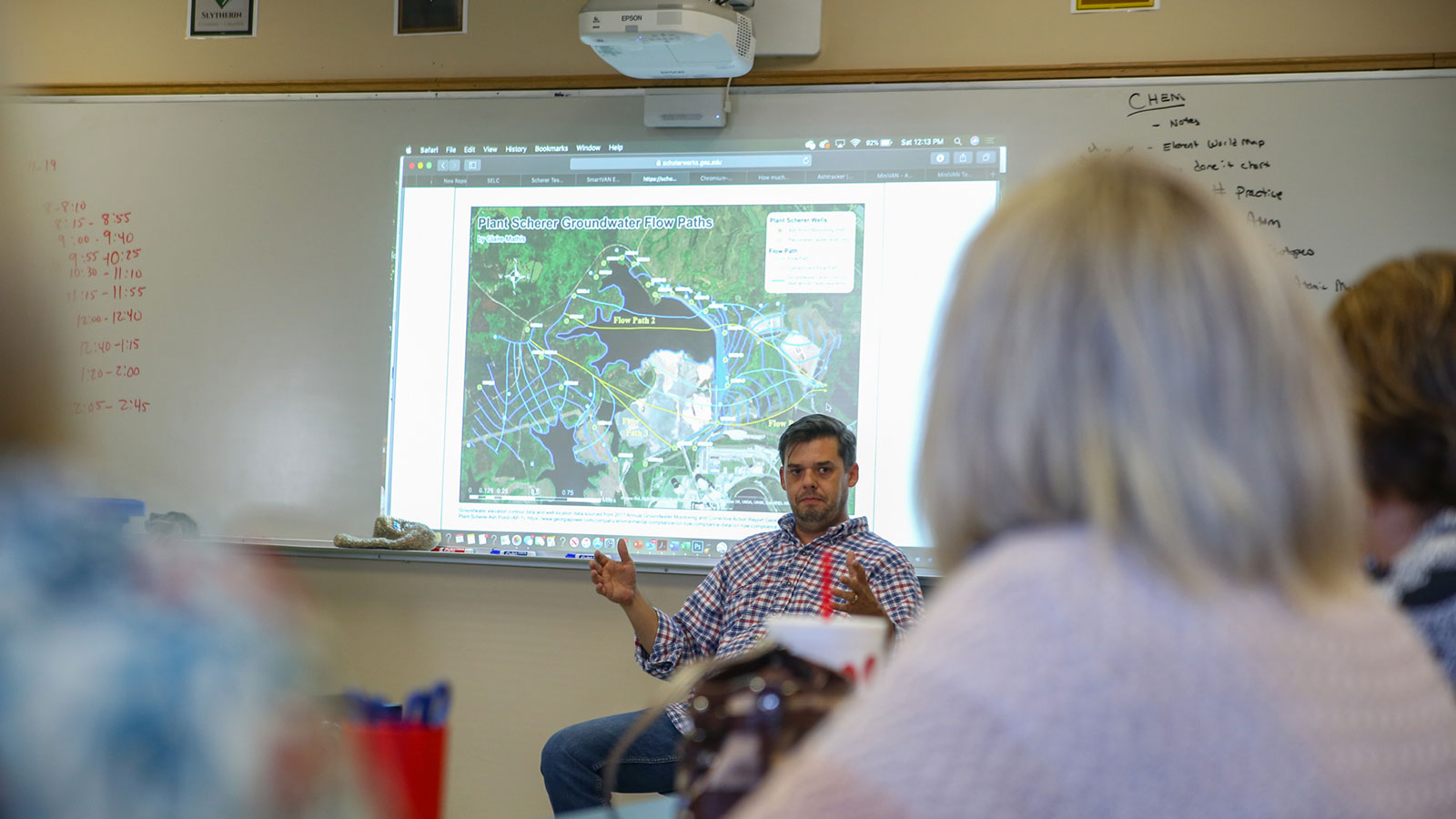
For its part, Georgia Power “stand[s] by the data delivered” from 57 groundwater monitoring wells at Scherer, indicating there’s been no seepage from Plant Scherer’s coal ash ponds, said spokesperson Crawford. The monitoring complies with federal and state laws and regulations that are analyzed by “third-party contractors for sampling and accredited independent laboratories for analysis.” And the company argues that its pond closure plans use “proven engineering methods specifically designed to be protective of groundwater and the environment.”
Sams doesn’t buy it. In the upcoming year, he hopes to collect 100 more samples, which he’s sure will turn up more contaminated drinking water. That evidence could spur more outrage. And that outrage could potentially force Georgia Power to store its coal ash somewhere other than its unlined ponds. He noted that the data would be made public so that he and the residents could use it for personal injury lawsuits, advocate for change with state lawmakers, and raise funding for more testing.
“If Georgia Power has their way, the groundwater will forever be contaminated,” Sams insisted. “If we can’t convince them to excavate, it’s over. This is our last hurrah.”
This past fall, before she left the Altamaha Riverkeeper, Hilburn walked inside Tony Bowdoin’s Juliette home and handed him a manila envelope with the test results from his well’s water. There were detectable levels of strontium, a constituent of coal ash linked to possible bone damage, and hexavalent chromium at a level of 4.3 parts per billion. The EPA does not have a drinking water standard solely for hexavalent chromium, but several states have strong standards for the carcinogen. California set a public health goal of 0.02 ppb of hexavalent chromium in drinking water in 2011 following the Erin Brockovich case. In 2015, North Carolina set a new baseline level for examining residents exposed to the metal at 0.07 ppb following the Duke Energy coal ash spill. The levels in Bowdoin’s well were more than 60 times higher than the North Carolina standard, according to the Riverkeeper’s third-party testing results, which were reviewed by Georgia Health News and Grist.

Bowdoin had initially hoped the results would ease his mind. Instead, they set his mind racing. Since having his well tested, he received another set of results that found Stage IV cancer in his colon. He knows it is incredibly difficult, if not impossible, to pinpoint the cause of the cancer. But he now wonders, after all these years, if the plant had poisoned his well — and his body.
“I hadn’t told anybody, but something wasn’t right with me,” Bowdoin said. “I’ve quit drinking the water.”
This story was funded and produced in collaboration with Georgia Health News, a statewide nonprofit health news publication.

